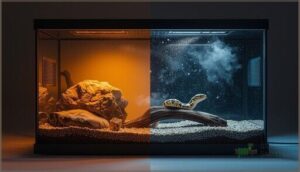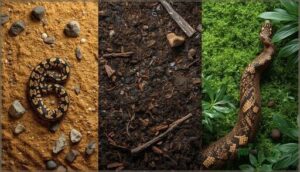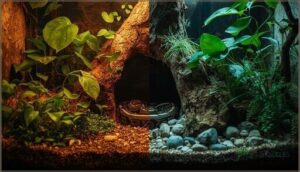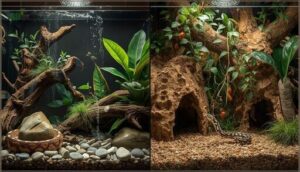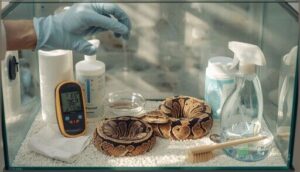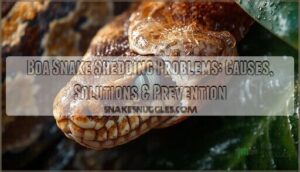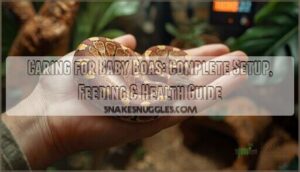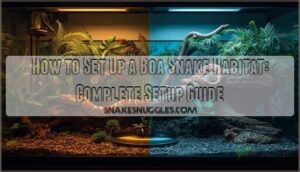This site is supported by our readers. We may earn a commission, at no cost to you, if you purchase through links.
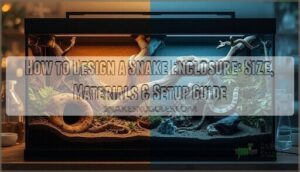
A poorly designed enclosure won’t just limit your snake’s movement—it can compromise thermoregulation, stress response, and long-term health outcomes. Many keepers underestimate how enclosure dimensions interact with species-specific behaviors, from the vertical climbing needs of arboreal colubrids to the extensive floor space required by active terrestrial species.
When you’re designing a snake enclosure, you’re fundamentally engineering a microhabitat that must support precise temperature gradients, humidity parameters, and behavioral enrichment opportunities. The difference between adequate and ideal housing often comes down to understanding the relationship between your snake’s morphology, natural history, and captive environmental requirements.
Table Of Contents
- Key Takeaways
- Determining The Right Enclosure Size
- Selecting Safe and Durable Materials
- Ensuring Proper Ventilation and Climate Control
- Incorporating Essential Design Features
- Enhancing Enclosure Interior and Enrichment
- Maintaining Snake Health and Hygiene
- Frequently Asked Questions (FAQs)
- How to build a custom snake enclosure?
- How do I create a functional snake enclosure?
- What tools do you need to build a snake enclosure?
- Where can I buy a snake enclosure?
- How does snake development affect a custom enclosure?
- How do I choose a good snake enclosure size?
- What lighting setup works best for corn snakes?
- How do I safely transport a custom enclosure?
- Can I house multiple snakes in one enclosure?
- Whats the ideal enclosure placement in my home?
- Conclusion
Key Takeaways
- Proper enclosure design requires matching dimensions to species-specific behaviors—minimum length should equal your snake’s full body length (preferably more), with width at 0.5× length and height adjusted for arboreal versus terrestrial movement patterns.
- Material selection directly impacts long-term health outcomes, with moisture-resistant options like PVC and sealed melamine preventing mold growth while aquarium-safe silicone sealing prevents chemical exposure and structural degradation.
- Creating functional temperature gradients (warm side 85–90°F, cool side 75–82°F) with proper ventilation (6–12 square inches distributed across multiple openings) enables thermoregulation and prevents respiratory infections that arise from stagnant, humidity-laden air.
- Environmental enrichment through species-appropriate substrate, multiple hides in different thermal zones, and rotating climbing structures every 2–4 weeks reduces stereotypic behaviors by 15% while supporting natural movement patterns and cognitive development.
Determining The Right Enclosure Size
Getting the enclosure size right isn’t just about keeping your snake contained—it’s about giving it enough space to move, thermoregulate, and exhibit natural behaviors. You’ll need to account for your snake’s current measurements, its expected adult dimensions, and how active its species is.
Let’s walk through the key factors that determine whether your enclosure will truly meet your snake’s needs.
Measuring Your Snake’s Length
How do you accurately capture your snake’s length when it won’t hold still? Use the curved spine method, following every twist and turn with flexible tape or string rather than forcing a straight line. Stretching force errors can skew your measurements by several inches, so let the snake rest naturally.
For nervous handlers, head length prediction offers a low-stress alternative that explains up to 95.9% of body length variation in many species.
Enclosure dimensions, including length, width, and height, define the usable space for the snake.
Planning for Adult Growth
Once you’ve captured your snake’s current length, shift your focus to adult species benchmarks. Growth rate varies dramatically—reticulated pythons can add 2–4 feet annually during juvenile stages, while ball pythons plateau after 2–3 years.
Upgrade frequency matters because over 42% of keepers house snakes in enclosures restricting full stretching. Sufficient space allows snakes to fully elongate and exhibit natural behaviors.
Space provision based on maximum anticipated snake length prevents health impacts like muscle atrophy and promotes behavioral activity throughout your animal’s life.
Applying Dimension Ratio Guidelines
With your snake’s adult size mapped out, you’ll translate that measurement into functional enclosure dimensions using established ratios. The minimum length debate centers on one key principle: your snake should stretch fully along at least one axis without bending.
Standard dimension ratio guidelines include:
- Enclosure length = 1.0 × snake length (minimum 0.66× per regulatory compliance standards)
- Width = 0.5 × snake length for adequate floor area calculations
- Height = 0.5–1.0 × snake length, adjusted for arboreal height needs
Reassessment frequency matters—measure every six months during growth phases to maintain proper tank size.
Considering Species Movement Patterns
Beyond static measurements, you need to account for how your snake actually moves. Different locomotion types demand distinct spatial provisions—rectilinear stretching requires full-body elongation, while concertina motion needs vertical and lateral opportunities.
| Behavior Factor | Design Implication |
|---|---|
| Habitat fidelity | Regular return routes need clear pathways |
| Activity range | Males average 656m vs. females’ 406m from refuges |
| Seasonal synchrony | Movement peaks above 3-week cycles require larger space |
| Daily displacement | 12–49m averages translate to active exploration zones |
Restricted enclosures impair natural snake behavior patterns greatly.
Selecting Safe and Durable Materials
Choosing the right materials for your snake enclosure isn’t just about durability—it’s about creating a safe, healthy environment that withstands moisture and regular cleaning.
The materials you select will directly impact your snake’s health, your maintenance routine, and the enclosure’s longevity.
Let’s examine the key material considerations that will help you build an enclosure your snake can thrive in for years to come.
Moisture-Resistant Options (PVC, Melamine)
When building a reptile habitat, material comparison starts with moisture resistance. PVC panels excel here—their closed-cell structure blocks water absorption even above 70% humidity, preventing mold and warping. PVC durability also means easier disinfection and stable temperature retention.
Melamine-coated particle board offers a smooth surface but demands melamine sealing at every edge with waterproof sealant to prevent particle board swelling.
Some keepers use hybrid designs, combining PVC shells with glass for visibility and enhanced moisture control.
Non-Toxic and Reptile-Safe Materials
After choosing moisture-resistant materials, you’ll need to verify their safety. Safe PVC and aquarium-safe silicone won’t leach chemicals, while toxic wood treated with arsenic poses serious risks. VOC concerns arise from nontoxic polyurethane and cleaning agents that haven’t fully cured—wait at least two weeks.
Choosing reptile-safe materials like reptile-safe epoxy ensures material durability without compromising your snake’s respiratory health through proper enclosure materials selection.
Sealing Joints and Edges Effectively
Once you’ve selected safe materials, proper sealing seams transforms your enclosure into a leakage prevention fortress. Apply aquarium-safe silicone along all joints after thorough surface cleaning—this joint preparation ensures strong adhesion.
Material-specific sealing matters: PVC requires different approaches than wood, though aquarium sealant works universally. Allow full curing for sealant durability.
Waterproof sealant application and quality adhesive prevent moisture infiltration, protecting both structure and inhabitant.
Material Safety for Cleaning and Maintenance
Your material choices directly influence cleaning effectiveness and long-term habitat hygiene. Rigid PVC and sealed wood withstand reptile-safe epoxy applications and safe disinfectants without degrading, while non-sealed surfaces invite bacterial growth and toxic chemical absorption.
Consider these material compatibility factors:
- F10SC or chlorhexidine-based products work safely on most enclosure surfaces when properly diluted
- Avoid ammonia or bleach-based cleaners—fumes persist and cause respiratory distress
- Clean every 2–3 months with spot-cleaning weekly to prevent bacterial colonization
- Rinse thoroughly after disinfection to eliminate residues that stress captive snakes
Best practices demand ventilation during cleaning and complete drying before reintroducing your animal.
Ensuring Proper Ventilation and Climate Control
Your snake can’t adjust its own body temperature, so the enclosure needs to do that work. Without proper airflow and climate zones, you’re looking at respiratory infections, poor digestion, and a stressed animal.
Snakes can’t regulate their own temperature, so poor airflow and climate zones lead to infections, digestive issues, and stress
Let’s walk through how to set up ventilation and temperature control that keeps your snake healthy and comfortable.
Creating Temperature Gradients
Temperature gradients are essential for your snake’s ability to thermoregulate, allowing it to move between different thermal zones to support digestion, metabolism, and overall health. To create these zones, you’ll need a heat mat or radiant panel on the warm side, regulated by a thermostat to prevent burns. Most species require a basking area with temperatures ranging from 85–90°F and a cooler zone between 75–82°F. Regular temperature monitoring with digital probes is crucial to ensure the gradient remains safe and meets the specific needs of your snake species.
| Zone | Temperature Range | Equipment | Purpose |
|---|---|---|---|
| Warm Side | 85–90°F (29–32°C) | Heat mat, radiant panel | Basking, digestion |
| Cool Side | 75–82°F (24–27°C) | Ambient room temp | Thermoregulation |
| Basking Spot | 90–95°F (32–35°C) | Overhead heating | Peak thermal activity |
| Nighttime | 65–75°F (18–24°C) | Reduced heat source | Rest, metabolic adjustment |
Installing Ventilation Systems
Your ventilation system determines whether your snake breathes clean air or battles respiratory infections in stagnant, moisture-laden conditions. Aim for 6 to 12 square inches of total ventilation area, distributed across multiple openings rather than concentrated in one spot.
Position low vents on the cool side just above substrate level and high vents on the warm side to establish natural airflow patterns that support climate regulation without sacrificing your carefully maintained humidity control.
Choosing Fans and Air Filters
You’ll want axial fans rated at 51 to 105 CFM depending on your enclosure width, always with UL certification for
Humidity Control and Airflow Management
Airflow alone won’t save your setup if humidity control fails. Balanced ventilation design with lower vents retaining heat and upper vents releasing moisture keeps humidity stable without creating drafts.
Substrate moisture, strategic misting systems, and heated water bowl placement all work together, while humidity monitoring with digital hygrometers prevents extremes that trigger respiratory problems or compromise snake health through improper temperature gradients.
Incorporating Essential Design Features
Beyond selecting the right size and materials, your enclosure’s functionality depends on thoughtful design features that make daily care easier and keep your snake secure. These structural elements aren’t just conveniences—they directly affect how well you can maintain proper conditions and prevent escape attempts.
Let’s examine the key features that separate a well-designed enclosure from one that creates constant headaches.
Easy-Access Panels for Maintenance
Beyond choosing the right materials, your snake enclosure should feature easy-access panels that simplify maintenance while preserving hygiene design. A well-designed opening panel—whether hinged or sliding—cuts cleaning efficiency time by up to 30% and reduces stress on your animal.
Consider these features when evaluating enclosure design features:
- Front-access panels that minimize overhead intrusion
- Removable trays for quick substrate changes
- Sealed edges that maintain humidity during spot cleaning
- Panel durability through scratch-resistant, moisture-proof materials
These workflow impact considerations and safety features transform routine care from a chore into a manageable task.
Escape-Proof Locks and Openings
An opening panel loses all value if your snake slips out unnoticed. In 2021 alone, 1,219 pet snakes escaped—roughly six incidents daily, peaking in warmer months when activity surges. Preventing escapes demands strong enclosure security through lock materials like zinc alloy, redundant systems (primary plus wire backup), and species behavior considerations.
Retrofitting security features like door wraps, solid grommets, and nail-down tracks closes gaps small snakes exploit. Position latches externally—internal access invites manipulation. Incident analysis reveals most escapes trace to improperly secured lids or structural discrepancies, so inspect seals and locks weekly.
| Lock Type | Security Feature | Best For |
|---|---|---|
| Wire locks | Prevents sliding door shifts | Glass enclosures |
| Magnetic locks | Child-safe, manipulation-resistant | Multi-user homes |
| Combination locks | Keyless, 1,000+ codes | High-risk species |
| Interlocking grips | Frame-tight closure | Side-opening panels |
Flat Pack and Easy-Assembly Designs
For those building their first DIY enclosure, flat pack designs deliver portability benefits without sacrificing material durability. Assembly time averages just 15-30 minutes using interlocking joints that reduce adhesive dependence by 70%.
User satisfaction hovers around 85% when designs incorporate easy-access panels and pre-cut ventilation slots.
These modular systems balance enclosure size flexibility with structural integrity, letting you adjust dimensions as your snake grows while maintaining proper ventilation throughout.
Weatherproofing and Moisture Sealing
Without proper moisture barriers, even the best-built enclosures fail within months. Aquarium-safe silicone sealants and three to five polyurethane coats create durable waterproof protection, cutting external moisture intrusion by 63%. Your sealing strategy should include:
- Pond liners for high-humidity species requiring 60–80% relative humidity
- Reptile-safe epoxy for joint reinforcement and long-term moisture resistance
- 72-hour curing periods that reduce VOCs below 15 parts per billion
- Outdoor-grade sealers extending enclosure lifespan by 4.5 years
- Annual resealing to maintain sealing standards and prevent 10% humidity decline
Enhancing Enclosure Interior and Enrichment
A well-designed enclosure isn’t complete without the right interior elements to support your snake’s physical and psychological needs. The substrate, climbing features, hiding spots, and decor you choose directly impact your snake’s activity levels, stress response, and overall health.
Here’s how to create an enriched environment that encourages natural behaviors and keeps your snake engaged.
Selecting Suitable Substrate Types
Your substrate selection shapes your snake’s health more than you might expect. Moisture-retaining substrates like coconut coir and sphagnum moss sustain humidity levels of 60-80%, supporting proper shedding and reducing respiratory issues by up to 50%.
Match substrate options to your species’ natural habitat composition—desert dwellers need arid materials with under 10% retention, while tropical species thrive in organic mixes.
Always verify toxicity safety and ensure appropriate substrate depth for burrowing behaviors.
Adding Climbing Structures and Ledges
Think of climbing structures as scaffolding for behavioral enrichment—arboreal species require vertical height exceeding horizontal space. Secure mounting prevents falls that cause injury; material grip matters since textured surfaces improve locomotion efficiency by 40%.
Scale ledge dimensions to your snake’s body length, placing them at varying heights.
This environmental enrichment directly reduces stereotypic behaviors while promoting thermoregulation, muscular development, and overall habitat setup success.
Providing Hiding Spots and Plant Covers
Hiding spots aren’t optional—they’re fundamental to stress reduction and proper temperature regulation in your reptile habitat. Position at least two hides in thermal zones to support natural behaviors, using non-toxic materials sized slightly larger than your snake’s girth for safety considerations.
- Live plants improve environmental enrichment through humidity stabilization and textured cover
- Proper hiding places reduce chronic stress that weakens immune function
- Plant benefits include shade creation and naturalistic concealment
- Strategic placement aids thermoregulation and promotes exploratory snake care behaviors
Rotating Decor for Sensory Stimulation
Your snake’s brain adapts and grows when you introduce new elements into its habitat. Rotating decor every two to four weeks boosts exploratory behavior by 24% and reduces stereotypic patterns by 15%.
Alternate climbing structures, varied textures, and hide configurations to optimize cognitive development and environmental enrichment.
This enrichment strategy transforms static reptile care into active sensory stimulation that mirrors natural snake behavior and promotes measurable welfare improvements.
Maintaining Snake Health and Hygiene
A well-designed enclosure won’t keep your snake healthy if you don’t maintain it properly. Beyond the initial setup, you need to watch for warning signs, control environmental conditions, and keep everything clean.
Here’s what you should focus on to prevent illness and create a hygienic habitat.
Recognizing Signs of Illness
When your snake refuses food for over one to two months, you’re likely witnessing early signs of illness that demand immediate attention. Recognizing signs of illness early helps prevent irreversible organ damage and ensures your snake’s long-term health.
Watch for appetite loss, abnormal shedding patterns, and neurological symptoms like disorientation or unusual posturing. Respiratory issues, including wheezing or nasal discharge, signal infection control problems.
Preventing Respiratory and Shedding Issues
Your enclosure’s environmental control directly determines respiratory health and shedding success. Maintain basking zones between 85–90°F and cooler areas around 75–80°F to support immune function, while keeping humidity between 50–70% for most species.
Install ventilation on opposite ends—low vents on the cool side, high vents on warm—to prevent stagnant air that breeds bacterial growth and respiratory infections.
Regular Cleaning and Disinfection
Maintaining snake habitat hygiene starts with weekly spot cleaning to remove waste and monthly deep cleans every 4–6 weeks.
Use veterinary-grade disinfectants like F10 SC (diluted 1:250) or chlorhexidine—never ammonia or pine-based products.
Soak décor in hot disinfectant solution, scrub thoroughly, and let surfaces stay wet for 5–10 minutes before air drying completely to prevent mold and respiratory irritation.
Monitoring Temperature and Humidity Levels
Beyond disinfection, your snake’s health depends on precise climate monitoring. Install combined digital thermometers and hygrometers to track temperature gradients (warm side 85–90°F, cool side 75°F) and humidity levels specific to your species—tropical snakes need 60–80%, desert species 30–50%.
Refined sensors with smartphone connectivity send real-time alerts when conditions drift, preventing respiratory infections and shedding complications before they start.
Frequently Asked Questions (FAQs)
How to build a custom snake enclosure?
You’ll achieve unmatched reptile safety and habitat creation when you master custom designs.
Start by choosing enclosure size based on adult length, then select moisture-resistant materials, install proper ventilation, and add enrichment features that encourage natural snake behavior.
How do I create a functional snake enclosure?
You’ll need to balance enclosure design, substrate selection, proper ventilation, and temperature gradients while monitoring snake behavior.
Habitat creation demands environmental monitoring, appropriate enclosure lighting, and attention to reptile nutrition for peak health.
What tools do you need to build a snake enclosure?
You’ll need a measuring tape, saw, power drill, router, and personal protective equipment.
Assembly materials like screws, clamps, and sealant complete your toolkit for constructing a secure, properly ventilated reptile habitat.
Where can I buy a snake enclosure?
You can purchase snake enclosures from online retailers like Zen Habitats or Kages, physical stores such as PetSmart, or explore used options through Facebook Marketplace. Custom builds offer species-specific designs worth comparing.
How does snake development affect a custom enclosure?
Growth considerations and behavioral changes directly shape enclosure size, enrichment needs, and space requirements. Juveniles develop faster with varied stimuli, while adult species demand proper dimensions to prevent health implications affecting snake health throughout development.
How do I choose a good snake enclosure size?
Your enclosure size requirements hinge on snake length measurement—match adult dimensions using dimension ratio guidelines. For corn snakes, apply 9 × 45 × 3 ratios while considering species movement analysis and growth prediction factors.
What lighting setup works best for corn snakes?
Your corn snake thrives with 12 hours of light daily using full-spectrum LEDs paired with low UVB (5-5%).
Position basking lights 10-18 inches away, creating temperature gradients while supporting natural circadian rhythms and calcium metabolism.
How do I safely transport a custom enclosure?
You’ll need proper packing techniques using bubble wrap and foam, sturdy transit methods with reinforced boxes, temperature control during shipment, structural integrity checks beforehand, and shipping insurance to protect your investment and guarantee enclosure security.
Can I house multiple snakes in one enclosure?
Housing multiple snakes together is strongly discouraged due to cohabitation risks including disease transmission, aggressive behavior, feeding competition, and chronic stress.
Most snake species are solitary and thrive individually, ensuring better snake health and animal welfare outcomes.
Whats the ideal enclosure placement in my home?
Think of your home as a patchwork of microclimates—each room offers distinct temperature stability, sunlight exposure, and noise levels.
Choose quiet spaces with consistent temperature regulation, proper ventilation, controlled humidity levels, and minimal household hazards for best enclosure design and accessibility.
Conclusion
The smallest mistakes in designing a snake enclosure often produce the largest consequences for your animal’s welfare. Your snake can’t adapt its physiology to poor housing—the enclosure must adapt to the snake.
You’ve now learned how precise dimensions, material choices, ventilation strategies, and enrichment elements interact to create a functional captive habitat. Apply these species-specific parameters with the same rigor you’d bring to any biological system, and you’ll establish conditions where thermoregulation, behavioral expression, and long-term health become achievable outcomes rather than fortunate accidents.
- https://responsiblereptilekeeping.org/cliffords-diadem-snake-husbandary-details/enclosure-size
- https://www.stumpscustomwood.com/keeping-up/find-the-perfect-fit-your-reptile-enclosure-size-guide
- https://www.reddit.com/r/snakes/comments/up4i1e/rule_of_thumb_for_enclosure_size/
- https://talis-us.com/blogs/news/corn-snake-heat-mat-temperature-guide
- https://reptilekages.com/blogs/blog-kages-ethical-reptile-keeping-starts-here/why-pvc-is-the-best-material-for-reptile-enclosures


